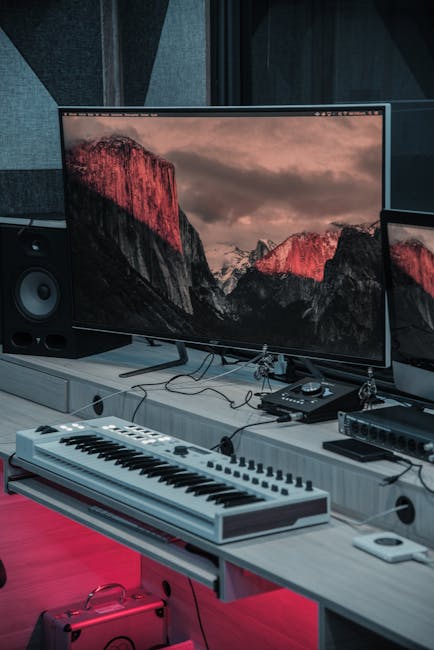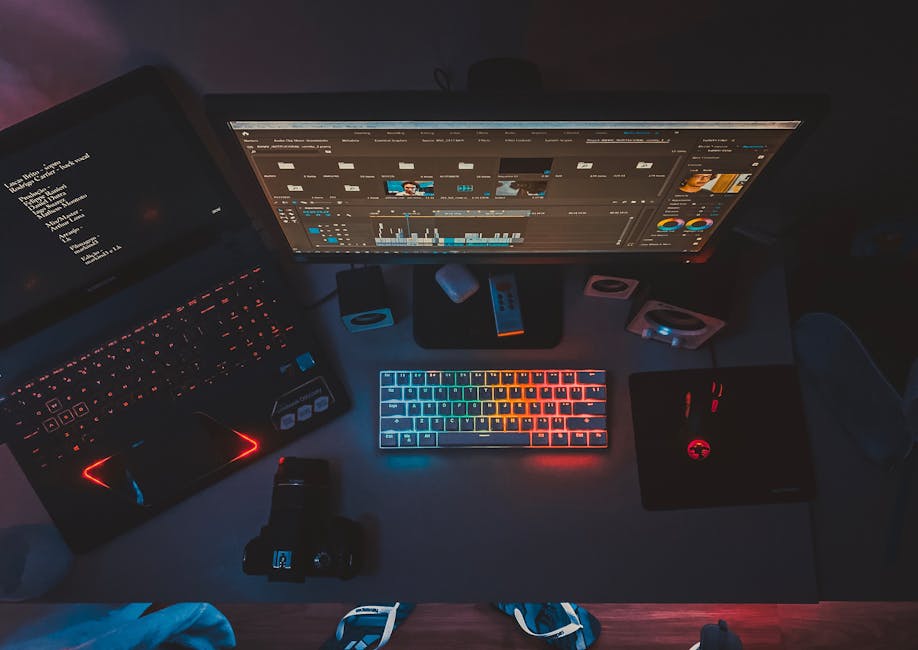Ultimate Guide: How to Connect Speakers to Your Monitor
In today’s world of immersive gaming, high-quality movie streaming, and productive work-from-home setups, audio plays a critical role in enhancing your experience. While many monitors come with built-in speakers, they often fall short in delivering the sound quality needed for a truly captivating audio-visual setup. Whether you’re a gamer frustrated by flat audio during intense multiplayer matches or a professional seeking clearer sound for virtual meetings, connecting external speakers to your monitor can be a game-changer. This ultimate guide is designed to walk you through every step of the process, addressing various connection methods, compatibility challenges, and troubleshooting tips to ensure you achieve the best sound possible.
With the rise of home office setups and gaming rigs, the demand for superior audio solutions has skyrocketed. Many users struggle with monitors that lack audio outputs or deliver subpar sound, making external speakers a must-have. This guide caters to all scenarios, whether you’re using a basic computer monitor or a high-end gaming display, and whether your speakers are wired, wireless, or part of a sophisticated soundbar system. We’ll cover everything from understanding your equipment to optimizing sound placement, ensuring you can tailor your setup to your specific needs.
Here’s what you can expect from this comprehensive guide:
- Why Connect Speakers? Understand the benefits and motivations behind enhancing your monitor’s audio.
- Equipment Basics: Learn about monitor audio outputs and speaker types to ensure compatibility.
- Connection Methods: Step-by-step instructions for wired and wireless setups.
- Audio Configuration: Tips to tweak settings on your computer for optimal sound output.
- Troubleshooting: Solutions to common issues like no sound or poor audio quality.
- Advanced Setups & Optimization: Explore multi-monitor audio routing and speaker placement tips.
- Maintenance & Upgrades: Keep your setup performing at its best with long-term care and enhancements.

Why Connect Speakers to Your Monitor?
Connecting external speakers to your monitor can significantly elevate your audio experience, addressing the limitations of built-in monitor speakers, which are often tinny, underpowered, or entirely absent. Whether you’re diving into an intense gaming session, editing videos with precise audio cues, or simply enjoying a movie night, external speakers provide the depth and clarity that most monitors can’t match. This upgrade is especially crucial for modern setups where audio quality directly impacts immersion and productivity.
Different use cases highlight the need for better sound. Gamers rely on directional audio to detect in-game cues, video editors require accurate sound reproduction for seamless cuts, and movie enthusiasts crave cinematic soundscapes that built-in speakers rarely deliver. Even in professional environments, clear audio during presentations or virtual calls can make a noticeable difference. Here are some key benefits of connecting external speakers to your monitor:
- Enhanced Audio Quality: External speakers often outperform monitor speakers with richer bass, clearer highs, and balanced mids.
- Customizable Sound Output: Tailor your audio with speakers designed for specific purposes, like bass-heavy systems for gaming or neutral sound for editing.
- Flexible Placement: Position speakers for optimal listening, creating a personalized soundstage around your workspace.
- Device Versatility: Many speakers can connect to other devices, offering value beyond just monitor use.
Before diving into the connection process, it’s essential to understand your equipment. Knowing the audio output options on your monitor and the input requirements of your speakers sets the foundation for a successful setup. Let’s explore this in the next section.

Understanding Your Equipment
Successfully connecting speakers to your monitor starts with a clear understanding of the hardware involved. Monitors and speakers come with a variety of ports and compatibility requirements, and mismatches can lead to frustration. This section will help you identify the audio output options on your monitor and the types of speakers available, ensuring you have the right tools and knowledge before proceeding with any connections.
Monitors typically offer several audio output methods, while speakers vary in their input needs and power requirements. Compatibility is key—knowing whether your monitor has a headphone jack, HDMI ARC, or Bluetooth capability will dictate the type of speaker or adapter you might need. Below, we’ll break down the essentials of monitor audio outputs and speaker categories, followed by a quick reference table to match them effectively.
| Monitor Output | Compatible Speaker Input | Required Cable/Adapter |
|---|---|---|
| 3.5mm Audio Jack | 3.5mm Input | 3.5mm Aux Cable |
| HDMI (with ARC) | RCA/Optical | HDMI Audio Extractor |
| DisplayPort | 3.5mm/RCA | DisplayPort Audio Adapter |
| USB-C | USB Input | USB-C to USB Cable |
| Bluetooth | Bluetooth Receiver | None (Wireless) |
Monitor Audio Outputs
Monitors can transmit audio through various ports, each with its own advantages and limitations. The most common include the 3.5mm headphone jack, often found on budget and mid-range monitors, which provides a simple wired connection. HDMI with ARC (Audio Return Channel) is prevalent in newer models and supports high-quality audio extraction to external devices, though it may require additional hardware. DisplayPort and USB-C are versatile options on premium monitors, capable of carrying audio signals alongside video, while Bluetooth offers a wireless solution on select models. Understanding your monitor’s capabilities—such as those on popular models like the Dell UltraSharp or LG UltraWide—is the first step to a seamless connection.
Types of Speakers
Speakers come in several forms, each suited to different needs and setups. Active speakers, like the Logitech Z906, are self-powered with built-in amplifiers, making them plug-and-play for most monitor connections. Passive speakers require an external amplifier, adding complexity but often delivering superior sound for audiophiles. Bluetooth speakers provide wireless convenience, ideal for clutter-free desks, while soundbars like the Bose Companion 2 offer compact solutions for cinematic audio. Knowing your speaker’s input and power requirements will guide you to the correct connection method, which we’ll cover in detail next.
Step-by-Step Connection Methods
Now that you’re familiar with your monitor’s audio outputs and the types of speakers available, it’s time to connect them. The process varies depending on the ports and technology at your disposal, but rest assured, this section provides detailed, beginner-friendly instructions for every common method. From direct wired connections to wireless Bluetooth setups, we’ve got you covered with step-by-step guides, pro tips, and visual aids to ensure success. Let’s dive into the most popular connection methods and the specific tools or adapters you might need.
| Connection Type | Required Cable/Adapter | Best For |
|---|---|---|
| 3.5mm Audio Jack | 3.5mm Aux Cable | Simple, budget setups |
| HDMI Audio Extraction | HDMI Audio Extractor, RCA Cable | High-quality audio |
| DisplayPort | DisplayPort to 3.5mm Adapter | Premium monitors |
| USB Audio | USB Cable/Adapter | Modern, compact speakers |
| Bluetooth | Bluetooth Transmitter (if needed) | Wireless convenience |
Direct 3.5mm Audio Jack Connection
- Locate the 3.5mm headphone jack on your monitor (usually labeled with a headphone icon).
- Plug one end of a 3.5mm aux cable into the monitor’s jack.
- Connect the other end to your speaker’s input port.
- Power on your speakers and test the audio with a video or song.
- If you hear static, ensure the cable is securely connected or try a shielded cable to reduce interference.
HDMI Audio Extraction Method
- Connect an HDMI cable from your computer to an HDMI audio extractor.
- Plug another HDMI cable from the extractor to your monitor for video.
- Use RCA or optical cables to connect the extractor’s audio output to your speakers.
- Power on all devices and select the correct input on your speakers.
- Check your computer’s audio settings to ensure HDMI output is selected.
DisplayPort Audio Connection
- 確認您的顯示器是否支援 DisplayPort 音頻輸出(例如 ASUS ROG 系列)。
- If needed, use a DisplayPort to 3.5mm audio adapter connected to your speakers.
- Plug the DisplayPort cable from your computer to the monitor.
- Connect the adapter’s audio output to your speakers using the appropriate cable.
- Test audio and adjust settings if necessary.
USB Audio Connection Options
- Check if your monitor or speakers support USB audio (e.g., Creative Pebble speakers).
- Connect a USB cable from your monitor or computer to the speakers.
- Install any required drivers if prompted by your system.
- Select the USB audio device as the output in your computer’s sound settings.
- Play audio to confirm the connection is working.
Wireless/Bluetooth Connection
- Verify if your monitor has built-in Bluetooth; if not, attach a Bluetooth transmitter to an audio output port.
- Turn on your Bluetooth speakers and set them to pairing mode.
- On your monitor or computer, search for nearby Bluetooth devices and select your speakers.
- Confirm pairing and test audio playback for latency or connection issues.
- Keep devices within range (typically 30 feet) for a stable connection.

Configuring Audio Settings on Your Computer
Once your speakers are physically connected to your monitor, the next crucial step is configuring your computer’s audio settings to ensure sound is routed correctly. Many connection issues stem from incorrect output device selection or misconfigured settings. This section provides clear instructions for both Windows and macOS users to set up and test their audio, ensuring you hear sound from your newly connected speakers.
Windows Audio Settings
- Right-click the speaker icon in the taskbar and select “Sounds” or “Sound settings.”
- In the “Playback” tab, find your speakers or monitor audio device and click “Set Default.”
- Click “Properties,” then check that the volume is up and the device is enabled.
- Test the audio by playing a sample sound or video.
- If no sound is detected, ensure drivers are updated via Device Manager.
macOS Audio Settings
- Go to “System Preferences” and select “Sound.”
- In the “Output” tab, choose your connected speakers or monitor audio device from the list.
- Adjust the output volume slider to a suitable level.
- Play audio to test the connection; check for balance and clarity.
- If issues persist, restart your Mac and recheck the settings.
Troubleshooting Common Issues
Even with careful setup, you might encounter issues like no sound, poor audio quality, or volume control problems when connecting speakers to your monitor. Don’t worry—most problems have straightforward solutions. This section addresses the most common issues with actionable fixes and a handy checklist to help you diagnose and resolve problems quickly.
| Issue | Possible Cause | Solution |
|---|---|---|
| No Sound | Wrong output selected | Check audio settings and select correct device |
| Poor Audio Quality | Interference or cheap cables | Use shielded cables or ground loop isolator |
| Volume Issues | Mismatched volume levels | Balance volume on monitor, speakers, and computer |
No Sound Despite Correct Connections
- Verify that the correct audio output device is selected in your computer’s sound settings.
- Ensure all cables are securely plugged in and speakers are powered on.
- Check if the monitor’s audio output is enabled (some monitors have internal settings).
- Update audio drivers for your computer or monitor if available.
Poor Audio Quality
- Replace low-quality cables with shielded ones to minimize interference.
- Consider a ground loop isolator if you hear humming or buzzing.
- Adjust equalizer settings on your computer or speakers for better sound balance.
- Move speakers away from electronic devices that might cause interference.
Volume Control Issues
- Check volume levels on all devices—computer, monitor, and speakers—to ensure they’re not muted or too low.
- If using HDMI or DisplayPort, ensure the audio output device controls the volume, not the monitor.
- Reset audio settings to default if software glitches are suspected.

Advanced Audio Setups
For users looking to go beyond basic connections, advanced audio setups can unlock even greater potential from your monitor and speaker system. Whether you’re managing a multi-monitor workspace or optimizing audio for gaming and entertainment, this section offers guidance on complex configurations, software tools, and performance tweaks.
Multiple Monitor Audio Routing
- Identify which monitor will be the primary audio output source.
- Use software like Voicemeeter to route audio to specific monitors or speakers.
- Connect audio switching devices if hardware routing is preferred.
- Test the setup to ensure audio plays from the correct source.
Gaming and Entertainment Optimization
- Enable virtual surround sound features on gaming speakers or through software like NVIDIA or AMD audio enhancements.
- Reduce latency by using wired connections over Bluetooth for real-time gaming.
- Balance game and chat audio using mixer software for multiplayer setups.
Optimizing Speaker Placement and Sound
The physical placement of your speakers can dramatically impact audio quality. Poor positioning may result in muffled sound or uneven stereo imaging, while optimal placement can create an immersive listening environment. This section provides practical tips to position your speakers effectively and adjust sound settings for your room’s acoustics.
- Place speakers at ear level, forming an equilateral triangle with your listening position for balanced stereo sound.
- Avoid placing speakers in corners or against walls to prevent bass buildup.
- Use speaker stands or mounts to adjust height and angle for direct sound projection.
- Experiment with EQ settings on your speakers or computer to tailor sound to your environment.
- Consider acoustic treatments like foam panels to reduce echo in larger rooms.

Maintenance and Upgrades for Long-Term Performance
Maintaining your speaker and monitor audio setup ensures consistent performance over time. Regular care can prevent issues like degraded sound quality, while strategic upgrades can elevate your experience further. Here’s how to keep your system in top shape and explore enhancement options.
- Maintenance Tips: Clean audio connectors regularly with contact cleaner sprays to avoid static or connection issues.
- Driver Updates: Keep your computer and monitor audio drivers updated for optimal compatibility.
- Cable Care: Store cables neatly to prevent wear and tear, replacing damaged ones promptly.
For upgrades, consider the following steps:
- Assess your current audio setup to identify limitations (e.g., lack of bass or clarity).
- Research affordable DACs like the FiiO E10K to enhance digital-to-analog conversion for better sound.
- Upgrade to higher-quality cables or speakers if budget allows, prioritizing compatibility with your monitor.
- Test the new components to ensure they integrate well with your existing system.
Frequently Asked Questions
Can any monitor output audio to speakers?
Yes, most monitors can output audio to speakers if they have compatible audio ports like a 3.5mm jack, HDMI with ARC, or Bluetooth. If your monitor lacks these, you may need an adapter or audio extractor (see “HDMI Audio Extraction Method” for details).
What is an HDMI audio extractor?
An HDMI audio extractor is a device that splits the audio signal from an HDMI connection, allowing you to send sound to external speakers while video goes to the monitor. It’s ideal for monitors without dedicated audio outputs.
What types of speakers work best with monitors?
– Active Speakers: Plug-and-play with built-in power, great for most setups.
– Passive Speakers: Offer high-quality sound but require an amplifier.
– Bluetooth Speakers: Convenient for wireless setups, though latency can be an issue.
– Soundbars: Compact and cinema-like, ideal for entertainment-focused desks.
How does a 3.5mm connection compare to Bluetooth for monitor audio?
A 3.5mm wired connection offers reliable, latency-free audio, ideal for gaming or real-time applications. Bluetooth provides wireless convenience but may introduce slight delays and depends on signal strength. Opt for wired if precision is key (see “Wireless/Bluetooth Connection” for setup tips).







